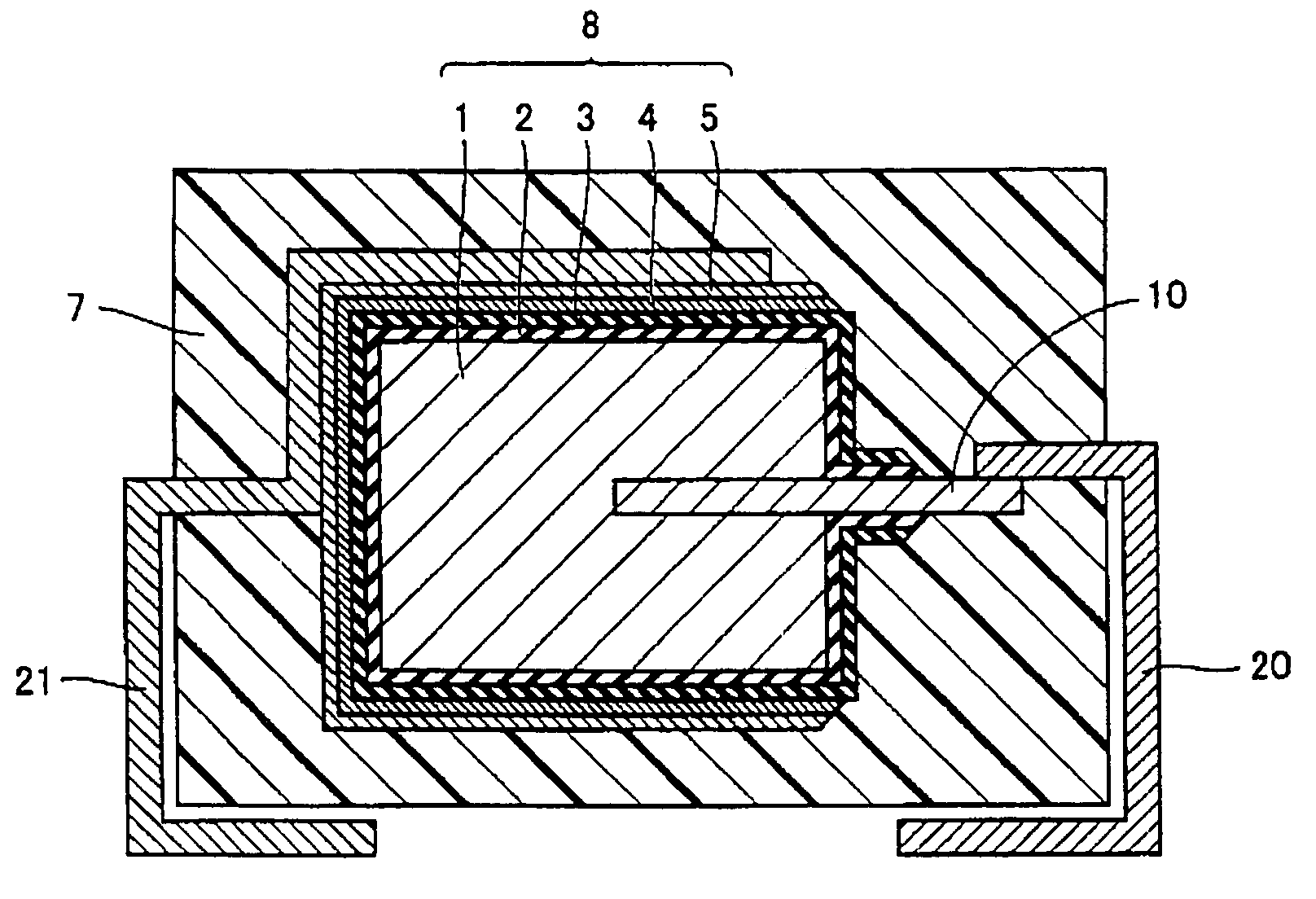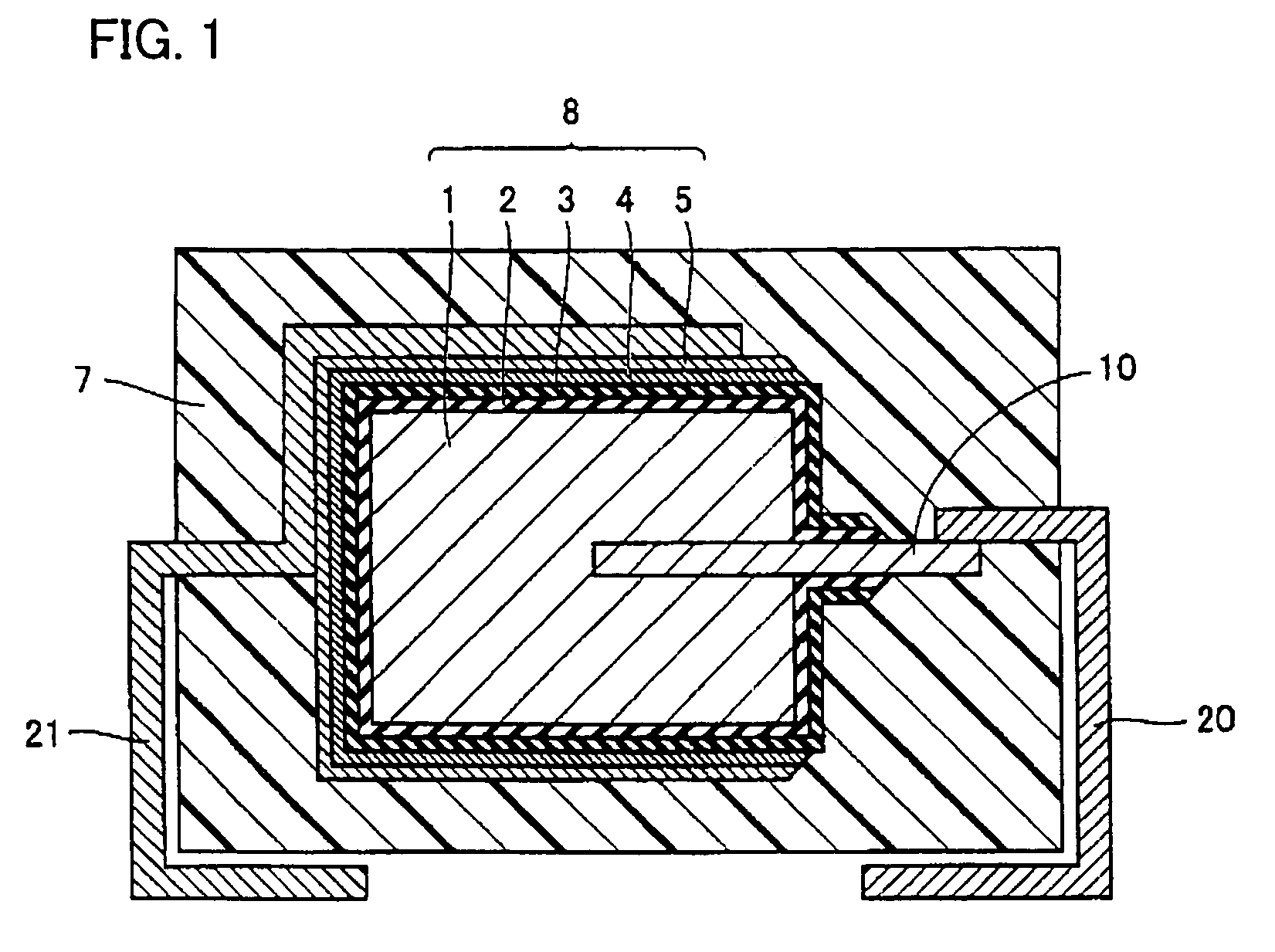Solid electrolytic capacitor
a technology of electrolytic capacitors and solids, which is applied in the direction of electrolytic capacitors, non-metal conductors, conductors, etc., can solve the problems of small degradation of capacitor capacity, inconvenient use of electrolyte solutions, and inability to meet the needs of large-capacity capacitors, etc., and achieves good heat resistance and low esr
- Summary
- Abstract
- Description
- Claims
- Application Information
AI Technical Summary
Benefits of technology
Problems solved by technology
Method used
Image
Examples
example 1
[0033]Referring to FIG. 1, for anode body 1 of a rectangular parallelepiped of 4.36 mm×3.26 mm×0.90 mm formed with sintered tantalum (Ta), having anode lead member 10 inserted thereto from one end surface thereof (a 3.26 mm×0.90 mm surface), anodic oxidation was performed in aqueous solution of phosphoric acid to form dielectric coating 2 on a surface thereof, and electrolytic polymerization was performed using a polymerization solution described below to form solid electrolyte layer 3 on dielectric coating 2. Then, carbon layer 4 and cathode extraction layer 5 were successively formed on solid electrolyte layer 3 to form capacitor element 8. Furthermore, anode terminal 20 was welded to anode lead member 10 and cathode terminal 21 was connected to cathode extraction layer 5 with a conductive adhesive, and thereafter, an outer surface of capacitor element 8 was covered and sealed with exterior resin 7 formed with an epoxy resin to make a solid electrolytic capacitor.
[0034]For forming...
examples 2 and 3
, COMPARATIVE EXAMPLES 1–4
[0036]Solid electrolytic capacitors were formed as described in example 1 except that compounds having molarities as shown in Table 1 were used as polymerization solutions of electrolytic polymerization, and the ESRs before and after the reflow were measured as in example 1. The results are shown in Table 1.
[0037]
TABLE 1ESRESRConductiveBeforeAfterMonomerDopantReflowReflow(Molarity)(Molarity)Dopant (Mol %)(mΩ)(mΩ)Example 1PyrroleBTHNBNBTHN (50)12.213.4(0.2)(0.1)(0.1)BN (50)Example 2PyrroleBTHNMNBTHN (50)16.218.1(0.2)(0.1)(0.1)BN (50)Example 3PyrroleBTHNDBBTHN (50)15.419.2(0.2)(0.1)(0.1)BN (50)ComparativePyrroleBTHN11.721.7Example 1(0.2)(0.2)ComparativePyrroleBN18.820.4Example 2(0.2)(0.2)ComparativePyrroleMN20.122.6Example 3(0.2)(0.2)ComparativePyrroleDB17.225.4Example 4(0.2)(0.2)BTHN: butyltetrahydronaphthalenesulfonate ionBN: butylnaphthalenesulfonate ionMN: methylnaphthalenesulfonate ionDB: dodecylbenzenesulfonate ion
[0038]As shown in a comparative example...
examples 4 – 8
EXAMPLES 4–8
[0040]Solid electrolytic capacitors were formed as described in example 1 except that compounds having molarities as shown in Table 2 were used as polymerization solutions of electrolytic polymerization, and the ESRs before and after the reflow were measured as in example 1. The results are shown in Table 2.
[0041]
TABLE 2ConductiveESR BeforeESR AfterMonomerDopantReflowReflow(Molarity)(Molarity)Dopant (Mol %)(mΩ)(mΩ)Example 4PyrroleBTHNBNBTHN (10)17.519.7(0.2)(0.02)(0.18)BN (90)Example 5PyrroleBTHNBNBTHN (30)15.817.3(0.2)(0.06)(0.14)BN (70)Example 6PyrroleBTHNBNBTHN (50)12.213.4(0.2)(0.1) (0.1) BN (50)Example 7PyrroleBTHNBNBTHN (70)12.114.8(0.2)(0.14)(0.06)BN (30)Example 8PyrroleBTHNBNBTHN (90)11.918.2(0.2)(0.18)(0.02)BN (10)BTHN: butyltetrahydronaphthalenesulfonate ionBN: butylnaphthalenesulfonate ion
[0042]As shown in examples 6 and 7 in Table 2, a solid electrolytic capacitor using BTHN and BN in a mol ratio of 5:5 or 7:3 in dopants maintained low ESRs before and after t...
PUM
| Property | Measurement | Unit |
|---|---|---|
| carbon number | aaaaa | aaaaa |
| temperature | aaaaa | aaaaa |
| temperature | aaaaa | aaaaa |
Abstract
Description
Claims
Application Information
 Login to View More
Login to View More - R&D
- Intellectual Property
- Life Sciences
- Materials
- Tech Scout
- Unparalleled Data Quality
- Higher Quality Content
- 60% Fewer Hallucinations
Browse by: Latest US Patents, China's latest patents, Technical Efficacy Thesaurus, Application Domain, Technology Topic, Popular Technical Reports.
© 2025 PatSnap. All rights reserved.Legal|Privacy policy|Modern Slavery Act Transparency Statement|Sitemap|About US| Contact US: help@patsnap.com



